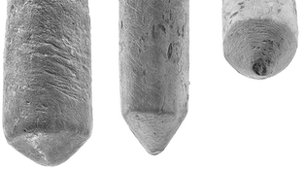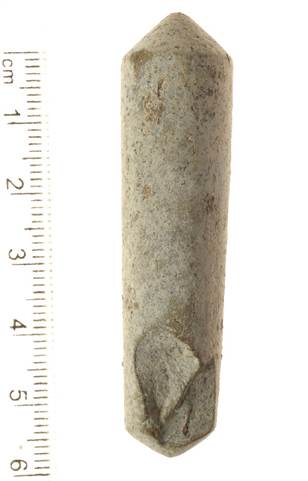It looks like you're using an Ad Blocker.
Please white-list or disable AboveTopSecret.com in your ad-blocking tool.
Thank you.
Some features of ATS will be disabled while you continue to use an ad-blocker.
3
share:
Despite being located many years ago, it seems we are finally putting away the Phallic mind of the gutter, and truly Lighting things up and getting
Hot.

It strikes me that the news that Archaeologists claim objects are earliest 'matches' and not the playtoys for the Ancients to have been using and abusing in the long wait for the Meat Man to return from his Hunting Trip, as a disservice to the Pagan/Cultic Ingenuity and their knack for turning all things into Sexual Pleasure Devices or Deviant Idols with Overtly Immense Proportions.
Who dares claim these Phallic Symbols, as they have previously been identified, are anything else but Phallic Symbols.
Well it seems these people have done just that.
SO, I guess we await Validation of this remarkable observation and seeing if these items, or "like" items do infact spark up things.
Ciao
Shane

It strikes me that the news that Archaeologists claim objects are earliest 'matches' and not the playtoys for the Ancients to have been using and abusing in the long wait for the Meat Man to return from his Hunting Trip, as a disservice to the Pagan/Cultic Ingenuity and their knack for turning all things into Sexual Pleasure Devices or Deviant Idols with Overtly Immense Proportions.
Who dares claim these Phallic Symbols, as they have previously been identified, are anything else but Phallic Symbols.
Well it seems these people have done just that.
Archaeologists claim objects are earliest 'matches'
By Nick Crumpton
BBC News
Researchers from Israel say that mysterious clay and stone artefacts from Neolithic times could be the earliest known "matches".
Although the cylindrical objects have been known about for some time, they had previously been interpreted as "cultic" phallic symbols.
The researchers' new interpretation means these could be the earliest evidence of how fires were ignited.
The research was published in the open access journal Plos One.
The journal reports that the artefacts are almost 8,000 years old.
Fire starters
Although evidence of "pyrotechnology" in Eurasia is known from three quarters of a million years ago, this evidence usually takes the form of remnants of fire itself.
"We have fire evidence in modern humans and Neanderthals, from charcoal, ashes and hearths, but there was nothing ever found that was connected with how you ignite the fire," lead author Prof Naama Goren-Inbar of The Hebrew University of Jerusalem told BBC News.
But on a visit to the Israel Museum in Jerusalem, Professor Goren-Inbar recognised the shape of structures discovered at the Sha'ar HaGolan archaeological site as that found in tools used for purposes other than simply cultural ones.
"I saw this object and immediately it came to my mind that this was very, very similar to all the sticks that you see [used as] 'fire drills'. I made the connection and it slowly developed," she said.
By using electro-microscopy techniques, Prof Goren-Inbar and her colleagues identified tell-tale signs that the cylindrical clay objects may have been rotated at high speed, generating friction to ignite tinder.
They identified linear marks, or striations - at the conical ends of the cylinders which they interpret as being generated by spinning the "matches" within sockets found on "fire boards", which are known from other sites.
Burn-colouration reminiscent of scorch-marks was also found, as well as grooves evident higher up the objects, which may have been generated by a bow, used to spin the cylinders.
This evidence, the researchers write, is supported by known cultural evidence from the Neolithic as well as knowledge of traditional fire ignition techniques.
This new interpretation highlights the technological sophistication of the Sha'ar HaGolan inhabitants at this time, and the prevalence of these structures around a wide area of the Eastern Mediterranean may further indicate that clay matches were common at an earlier time period than other ignition technologies.
Prof Goren-Inbar told BBC News that the team intended to carry out further experimental work in order to validate their conclusions.
SO, I guess we await Validation of this remarkable observation and seeing if these items, or "like" items do infact spark up things.
Ciao
Shane
Great post..when will the results of this logical observation be available?
edit on 11-8-2012 by Ericthenewbie because: grammar,lol
there's this ancient lopsided, but obviously shaped stones that are similar to discus.
(Older than the
Roman one.) It was discovered that when they were hurled up in the air, they all faced the same direction when falling, leaving the sharp end
pointing down. It is assumed that it was meant as a hunting tool.
In another report, they indicate where the World's
earliest-known 'matches' where located, and give some information /details not noted previously

There is good news though. For those who are bummed out about these recent developments, there is an upside.
Ciao
Shane
When small cylinders of clay and stone turned up at ancient archaeological sites, researchers described them as "phallic" and theorized the pointy-tipped cylinders had religious significance.
But regardless of the resemblance they bear to male genitalia, these cylinders had a practical purpose: They were the world's earliest-known matches, an Israeli research team concluded after examining one of the sites holding these "early matches."
After examining cylinders found at an 8,000-year-old site in a Neolithic village called Sha'ar HaGolan in modern-day Israel, the team determined they were rotated against another surface to generate friction, which would generate heat and, ultimately, fire.
This system, called a fire drill, relies on drill bits — the role the researchers believe these cylinders played — and a fire board that also holds tinder.
Drills and boards have shown up in archaeological sites around the world, including Egypt, Europe and South America. They have also been used by people such as Australian aborigines and American Indians.

There is good news though. For those who are bummed out about these recent developments, there is an upside.
But phallic advocates take heart, "ethnographically, in many societies the fire drill and the fireboard are considered to represent the male and female sex organs, respectively," they write.
Ciao
Shane
new topics
-
America's Greatest Ally
General Chit Chat: 16 minutes ago -
President BIDEN's FBI Raided Donald Trump's Florida Home for OBAMA-NORTH KOREA Documents.
Political Conspiracies: 5 hours ago -
Maestro Benedetto
Literature: 6 hours ago -
Is AI Better Than the Hollywood Elite?
Movies: 6 hours ago -
Las Vegas UFO Spotting Teen Traumatized by Demon Creature in Backyard
Aliens and UFOs: 10 hours ago -
2024 Pigeon Forge Rod Run - On the Strip (Video made for you)
Automotive Discussion: 11 hours ago -
Gaza Terrorists Attack US Humanitarian Pier During Construction
Middle East Issues: 11 hours ago
top topics
-
President BIDEN's FBI Raided Donald Trump's Florida Home for OBAMA-NORTH KOREA Documents.
Political Conspiracies: 5 hours ago, 26 flags -
Krystalnacht on today's most elite Universities?
Social Issues and Civil Unrest: 16 hours ago, 9 flags -
Gaza Terrorists Attack US Humanitarian Pier During Construction
Middle East Issues: 11 hours ago, 8 flags -
Supreme Court Oral Arguments 4.25.2024 - Are PRESIDENTS IMMUNE From Later Being Prosecuted.
Above Politics: 16 hours ago, 8 flags -
Weinstein's conviction overturned
Mainstream News: 14 hours ago, 8 flags -
Massachusetts Drag Queen Leads Young Kids in Free Palestine Chant
Social Issues and Civil Unrest: 13 hours ago, 7 flags -
Las Vegas UFO Spotting Teen Traumatized by Demon Creature in Backyard
Aliens and UFOs: 10 hours ago, 6 flags -
Meadows, Giuliani Among 11 Indicted in Arizona in Latest 2020 Election Subversion Case
Mainstream News: 13 hours ago, 5 flags -
2024 Pigeon Forge Rod Run - On the Strip (Video made for you)
Automotive Discussion: 11 hours ago, 4 flags -
Is AI Better Than the Hollywood Elite?
Movies: 6 hours ago, 3 flags
3
